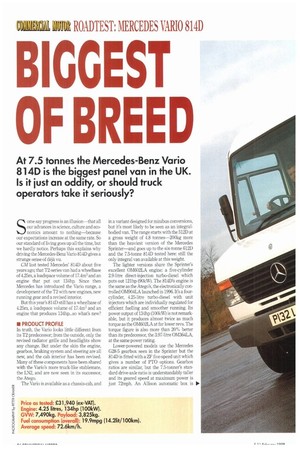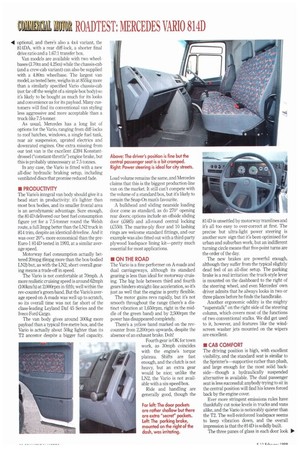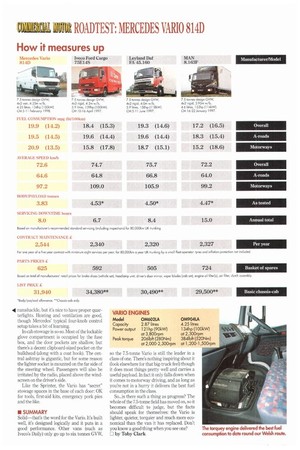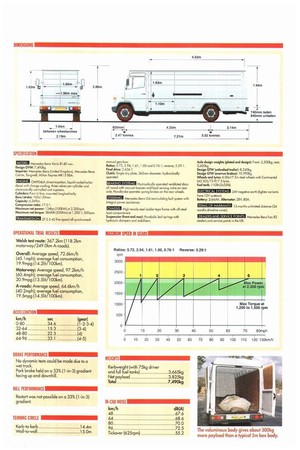ROADTEST: MERCEDES VARIO 814D
Page 28

Page 30

Page 32

Page 29

Page 31

If you've noticed an error in this article please click here to report it so we can fix it.
At 7.5 tonnes the Mercedes-Benz Vario 814D is the biggest panel van in the UK. Is it just an oddity, or should truck operators take it seriously?
Some say progress is an illusion—that all our advances in science, culture and economics amount to nothing—because our expectations increase at the same rate. So our standard of living goes up all the time, but we hardly notice. Perhaps this explains why driving the Mercedes-Benz Vario 814D gives a strange sense of déjà vu_
CM last tested Mercedes' 814D about five years ago; that T2-series van had a wheelbase of 425m, a loadspace volume of 17.4mand an engine that put out 134hp. Since then Mercedes has introduced the Vario range, a development of the T2 with new engines, new running gear and a revised interior.
But this year's 814D still has a wheelbase of 4.25m, a loadspace volume of 17.4m3 and an engine that produces 134hp...so what's new?
• PRODUCT PROFILE
In truth, the Vario looks little different from its T2 predecessor; from the outside, only the revised radiator grille and headlights show any change. But under the skin the engine, gearbox, braking system and steering are all new, and the cab interior has been revised. Many of these components have been shared with the Vario's more truck-like stablemate, the LN2, and are now seen in its successor, the Atego.
The Vario is available as a chassis-cab, and in a variant designed for minibus conversions, but it's most likely to be seen as an integralbodied van. The range starts with the 512D at a gross weight of 4.8 tonnes-200kg more than the heaviest version of the Mercedes Sprinter—and goes up to the six-tonne 612D and the 7.5-tonne 814D tested here: still the only integral van available at this weight.
The lighter versions share the Sprinter's excellent 0M602LA engine: a five-cylinder 2.9-litre direct-injection turbo-diesel which puts out 121hp (90kW). The 814D's engine is the same as the Atego's, the electronically controlled 0M904LA launched in 1996. It's a fourcylinder, 4,25-litre turbo-diesel with unit injectors which are individually regulated for efficient fuelling and smoother running. Its power output of 134hp (100kW) is not remarkable, but it produces almost twice as much torque as the 01V1602LA at far lower revs. The torque figure is also more than 20% better than its predecessor, the 3.97-litre 0M364LA, at the same power rating, Lower-powered models use the Mercedes G28-5 gearbox seen in the Sprinter but the 814D is fitted with a ZF five-speed unit which gives a number of PTO options. Gearbox ratios are similar, but the 7.5-tonner's standard drive-axle ratio is understandably taller and its geared speed at maximum power is just 72mph. An Allison automatic box is • optional, and there's also a 4x4 variant, the 814DA, with a rear diff-lock, a shorter final drive ratio and a 1.67:1 transfer box.
Van models are available with two wheelbases (3.70m and 4.25m) while the chassis-cab (and a crew-cab variant) can also be supplied with a 4.80m wheelbase. The largest van model, as tested here, weighs in at 855kg more than a similarly specified Vario chassis-cab (not far off the weight of a simple box body) so it's likely to be bought as much for its looks and convenience as for its payload. Many customers will find its conventional van styling less aggressive and more acceptable than a truck-like 7.5-tonner.
As usual, Mercedes has a long list of options for the Vario, ranging from diff-locks to roof hatches, windows, a single fuel tank, rear air suspension, uprated electrics and downrated engines. One extra missing from our test van is the excellent £394 Konstantdrossel ("constant-throttle") engine brake, but this is probably unnecessary at 7.5 tonnes.
In any case, the Vario is fitted with a new all-disc hydraulic braking setup, including ventilated discs that promise reduced fade.
• PRODUCTIVITY The Vario's integral van body should give it a head start in productivity: it's lighter than most box bodies, and its smaller frontal area is an aerodynamic advantage. Sure enough, the 814D delivered our best fuel consumption figure yet for a 7.5-tonner round the Welsh route, a full 3mpg better than the LN2 truck in 814 trim, despite an identical driveline. And it was over 20% more economical than the preEuro-1 814D tested in 1993, at a similar average speed.
Motorway fuel consumption actually bettered 20mpg (6mpg more than the box-bodied LN2) but, as with the LN2, short overall gearing means a trade-off in speed.
The Vario is not comfortable at 70mph. A more realistic cruising speed is around 62mph (100km/h) at 2,000rpm in fifth; well within the rev-counter's green band. But the Vario's average speed on A-roads was well up to scratch, so its overall time was not far short of the class-leading Leyland Daf 45 Series and the Iveco Ford Cargo.
The van body gives around 300kg more payload than a typical five-metre box, and the Vario is actually about 50kg lighter than its T2 ancestor despite a bigger fuel capacity. Load volume remains the same, and Mercedes claims that this is the biggest production-line van on the market. It still can't compete with the volume of a standard box, but it's likely to remain the Snap-On man's favourite.
A bulkhead and sliding nearside loading door come as standard, as do 270° opening rear doors; options include an offside sliding door (£685) and all-round central locking (£550). The marine-ply floor and 10 lashing rings are welcome standard fittings, and our example was also fitted out with a third-party plywood loadspace lining kit—pretty much essential for most applications.
• ON THE ROAD The Vario is a fine performer on A-roads and dual carriageways, although its standard gearing is less than ideal for motorway cruising. The big hole between third and fourth gears hinders straight-line acceleration, so it's just as well that the engine is pretty flexible.
The motor gains revs rapidly, but it's not smooth throughout the range (there's a distinct vibration at 1,650rpm, right in the middle of the green band) and by 2,500rpm the power has disappeared completely.
There's a yellow band marked on the revcounter from 2,200rpm upwards, despite the absence of an exhaust brake. Doh!
Fourth gear is OK for town work, as 30mph coincides with the engine's torque plateau. Shifts are fast enough, and the clutch is not heavy, but an extra gear would be nice; unlike the LN2, the Vario is not available with a six-speed box.
Ride and handling are generally good, though the 814D is unsettled by motorway tramlines and it's all too easy to over-correct at first. The precise but ultra-light power steering is another sure sign that it's been optimised for urban and suburban work, but an indifferent turning circle means that five-point turns are the order of the day.
The new brakes are powerful enough, although they suffer from the typical slightly dead feel of an all-disc setup. The parking brake is a real irritation: the truck-style lever is mounted on the dashboard to the right of the steering wheel, and even Mercedes' own driver admits that he always looks in two or three places before he finds the handbrake.
Another ergonomic oddity is the mighty "superstalk" on the right side of the steering column, which covers most of the functions of two conventional stalks. We did get used to it, however, and features like the windscreen washer jets mounted on the wipers are excellent.
• CAB COMFORT The driving position is high, with excellent visibility and the standard seat is similar to the Sprinter's—supportive rather than plush, and large enough for the most solid backside—though a hydraulically suspended alternative is available. The dual passenger seat is less successful: anybody trying to sit in the central position will find his knees forced back by the engine cover, Ever more stringent emissions rules have thankfully cut noise levels in trucks and vans alike, and the Vario is noticeably quieter than the 12. The well-reinforced loadspace seems to keep vibration down, and the overall impression is that the 814D is solidly built.
The three panes of glass in each door look
1 ramshackle, but it's nice to have proper guarterlights. Heating and ventilation are good, though Mercedes typical four-knob control setup takes a bit of learning.
In-cab stowage is so-so. Most of the lockable glove compartment is occupied by the fuse box, and the door pockets are shallow, but there's a decent clipboard-sized pocket on the bulkhead (along with a coat hook). The central ashtray is gigantic, but for some reason the lighter socket is mounted on the far side of the steering wheel. Passengers will also be irritated by the radio, placed above the windscreen on the driver's side.
Like the Sprinter, the Vario has "secret" stowage spaces in the base of each door: OK for tools, first-aid kits, emergency pork pies and the like.
• SUMMARY Solid-that's the word for the Vario. It's built well, it's designed logically and it puts in a good performance. Other vans (such as Iveco's Daily) only go up to six tonnes GVW, so the 7.5-tonne Who is still the leader in a class of one. There's nothing inspiring about it (look elsewhere for that big-truck feel) though it does most things pretty well and carries a useful payload. In fact it only falls down when it comes to motorway driving, and as long as you're not in a hurry it delivers the best fuel consumption in the class.
So...is there such a thing as progress? The whole of the 7.5-tonne field has moved on, so it becomes difficult to judge, but the facts should speak for themselves: the Vario is lighter, quieter, torquier and much more economical than the van it has replaced. Don't you know a good thing when you see one?
CI by Toby Clark Price as tested: £31,940 (ex-VAT).
Engine: 4.25 litres, 134hp (100kW). GVVV: 7,490kg. Payload: 3,825kg. Fuel consumption (overall): 19.9mpg (14.21it/100km). Average speed: 72.6km/h.
VARIO VAN VARIANTS
Model GVW Engine Wheelbase Load volume (high-roof) 512D 4,800k9 0M602 3.70m 13.3m3 (14.3m3) 612D 5,990k9 0M602 3.70m 13.3m3 (14.3m3) 612D 5,990k9 0M602 4.25m 17.4m3 814D 7,490k9 0M904 3.70m 13.3m3 (14.3m3) 814D 7,490kg 0M904 4.25m 814DA (4x4) 7,490kg 0M904 3.70m 13,3m3 (14.3m3.) (14.3m3)
SPECIFICATION
Mercedes-Benz Vario 814D van. Design GVW: 7,490kg. MODEL
Importer: Mercedes-Benz (United Kingdom), Mercedes-Benz Centre, Tongwell, Milton Keynes MK 15 884.
0m904LA direct-injection, liquid-coded turbodiesel with charge cooling, three valves per cylinder and electronically controlled unit iniectors.
Cylinders: Four in line, mounted longitudinally.
Bore/stroke: 102x130mm, Capacity: 4,249cc.
Compression ratio: 170-I .
Maximum net power: I 34h0 (100kW) at 2,300rpm. Maximum net torque: 3841bh (520Nm) at 1,200.1,500rpm.
EMIZIEM ZF S 5-42 five-speed all-synchromesh manual gearbox.
Ratios: 5.72, 2.94, 1.61, 1.00 ond 0.76:1; reverse, 5 29.-1, Final drive: 3.636-1.
Clutch: Single dry plate, 362mm diameter, hydraulically operated.
Hydraulically operated ventilated discs aI round with vacuum booster and lo-sensing valve on rear axle. Handbrake operates spring brakes on the rear wheels.
BRAKING SYSTEMS
MEZERI Mercedes-Benz 134 recirculating ball system with iriegto power assistance.
111012121 High-tensile steel ladder-type frame with all-steel Lao comportment.
Suspension Front and rear): Parabolic leaf springs with hydraulic dampers and stabilisers Axle design weights 'plated and design): Front, 2,500kg, rear,
5,600kg.
Design GTW (unbraked trailer): 8,240kg.
Design GTW (overrun brakes): 10,990kg
Wheels and tyres: 6.00x17 5in steel wheels with Continental
L45 205/75 RI 75 tyres.
Fuel tank: 1 101iti2x551it) CIESIEMISMIE1 24v negative earth (lighter variants have 12V sysierr sl
Battery: 2x66All Alternator: 28V, 80A.
TERMS OF WARRANTY: 12 months unlimited distance (24 mostbs driveline covet: DEALERS AND SERVICE POINTS. Mercedes-Benz has 82 coolers sic service points in the UK.
OPERATIONAL TRIAL RESULTS Welsh test route: 367.2km (118.2km motorway/249.0km A-roads).
Overall: Average speed, 72.6km/h (45.1mph); average fuel consumption, 19.9mpg (14.214/100km).
Motorway: Average speed, 97.2km/h (60.4mph); average fuel consumption, 20.9mpg (13.51it/100km).
A-roads: Average speed, 64.6km/h (40.2mph); average fuel consumption, 19.5mpg (14.51it/100km).
BRAKE PERFORMANCE No dynamic tests could be made due to a wet track.
Pork brake held on a 33% (1-in-3) gradient facing up and downhill. WEIGHTS Kerbweight (with 75kg driver and full fuel tanks) 3,665kg Net payload 3,825kg
Total 7,490kg HILL PERFORMANCE
Restart was not possible on 033% (1-in-3) gradient.
TURNING CIRCLE
Kerb-to-kerb 14.4m Wall-to-wall 15.0m








































































































